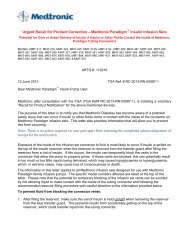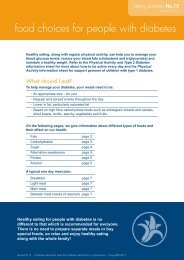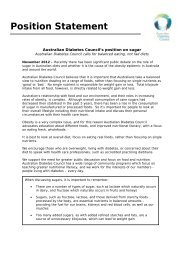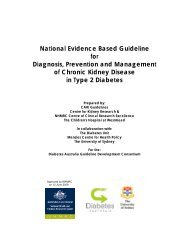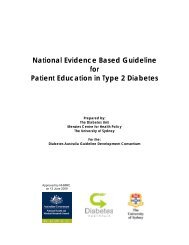Part 6: Detection and Prevention of Foot Problems in Type 2 Diabetes
Part 6: Detection and Prevention of Foot Problems in Type 2 Diabetes
Part 6: Detection and Prevention of Foot Problems in Type 2 Diabetes
Create successful ePaper yourself
Turn your PDF publications into a flip-book with our unique Google optimized e-Paper software.
Evidence Table: Section 12AuthorEconomic ConsiderationsLevel <strong>of</strong> EvidenceLevel Study <strong>Type</strong>EvidenceQualityRat<strong>in</strong>gMagnitudeRat<strong>in</strong>gRelevanceRat<strong>in</strong>gBenotmane A (2001)(Adults – France)III-2 Cohort High High + HighGirod I (2003)(Adults – France)III-2 Cross-sectional High High + HighGordois (2004)(Adults – US)III-2 Cross-sectional High High HighHorswell RL (2003)(Adults – US)III-2 Cohort Medium High + HighHosk<strong>in</strong>s (1994)(Adults – Australia)III-2 Cohort Medium High HighKantor J (2001)(Adults – US)III-2 Cohort Medium Medium MediumOrtegon MM (2004)(Adults – TheIII-2 Cohort Medium High + HighNetherl<strong>and</strong>s)Ramsey SD (1999)(Adults – US)III-2 Cohort High High + HighVan Acker K (2000)(Adults – Belgium)III-2 Cohort High High HighFor magnitude rat<strong>in</strong>g:+<strong>in</strong>dicates negative effect (or impact) <strong>of</strong> lower socioeconomic status on diabetic foot disease. High = cl<strong>in</strong>ically important &statistically significant; Medium = small cl<strong>in</strong>ical importance & statistically significant; Low = no statistically significant effect.Criteria for Quality <strong>and</strong> Relevance rat<strong>in</strong>gs are detailed <strong>in</strong> Appendix 9.95






